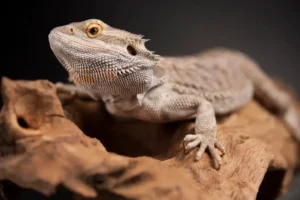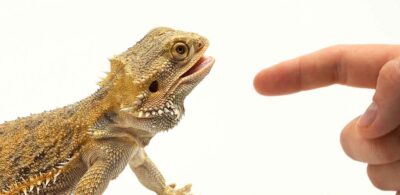If you’re a proud owner or a prospective enthusiast of bearded dragons, you’ve likely wondered at some point, “Do bearded dragons bite, and does it hurt?” The prospect of a pet lizard sinking its teeth into your skin might sound alarming, but fear not—let’s demystify this aspect of bearded dragon behavior.
Bearded dragons, known for their docile and friendly nature, are generally not prone to aggressive behavior. However, like any creature, they may bite under certain circumstances. In this exploration, we’ll delve into the reasons behind bearded dragon bites, the likelihood of experiencing one, and most importantly, whether these bites are actually painful.
Do bearded dragons bite?

Yes, bearded dragons can bite, but it is not their typical behavior. Bearded dragons are generally known for their calm and docile nature. They are often chosen as pets because of their friendly disposition. However, like any animal, they may bite in certain situations.
Common reasons for a bearded dragon to bite include:
- Feeling threatened: If a bearded dragon feels threatened or cornered, it may bite as a defensive response.
- Territorial behavior: Some bearded dragons may exhibit territorial behavior, especially if they encounter another dragon or perceive a threat.
- Hunger: If a bearded dragon mistakes your fingers for food, it might bite while trying to eat.
- Handling issues: Improper handling, especially if the dragon is not used to being picked up or feels uncomfortable, can lead to defensive behaviors, including biting.
To minimize the risk of being bitten, it’s essential to handle your bearded dragon gently and with care. Always approach them slowly and allow them to get accustomed to your presence. Regular, gentle handling can help build trust between you and your pet.
If you are concerned about your bearded dragon’s behavior or if it starts biting frequently, it’s a good idea to consult with a reptile veterinarian or an experienced reptile keeper for guidance.
Common concerns about bearded dragons biting
Common concerns about bearded dragons biting often revolve around the reasons behind the behavior and potential consequences. Here are some specific concerns related to bearded dragon bites:
- Injury to the owner: Bearded dragon bites can cause minor injuries such as scratches or puncture wounds. While these injuries are usually not severe, they can become infected if not properly cleaned.
- Stress for the bearded dragon: Frequent biting may indicate that the bearded dragon is stressed or feels threatened. This can negatively impact the dragon’s overall well-being and health.
- Fear of handling: If a bearded dragon bites during handling, the owner may become hesitant or fearful of interacting with their pet. This can lead to a strained relationship between the owner and the dragon.
- Misunderstanding aggression: Biting may be misinterpreted as aggression, leading to concerns about the temperament of the bearded dragon. In many cases, bites are defensive reactions rather than aggressive behavior.
- Health concerns: Persistent or sudden changes in behavior, including increased aggression, could be a sign of underlying health issues. Owners may worry that biting is a symptom of illness or discomfort.
To address these concerns, it’s essential for bearded dragon owners to understand their pets’ needs and behaviors. Regular handling, proper husbandry, and creating a comfortable environment can help reduce stress and minimize the likelihood of biting.
If a bearded dragon’s behavior changes suddenly or if there are ongoing concerns, consulting with a reptile veterinarian is advisable to rule out any health issues and receive guidance on proper care and handling techniques.
Minimizing the Risk of Being Bitten
Minimizing the risk of being bitten by a bearded dragon involves understanding their behavior and taking steps to create a positive and stress-free environment. Here are some tips to help reduce the likelihood of bites:
- Frequent Handling:
- Begin handling your bearded dragon regularly from a young age to help them become accustomed to human interaction.
- Start with short sessions and gradually increase the duration as your dragon becomes more comfortable.
- Approach Slowly:
- Avoid sudden movements or loud noises that could startle your bearded dragon.
- Approach them calmly and gently to avoid triggering a defensive response.
- Respect Their Space:
- Bearded dragons can be territorial, so allow them space and avoid reaching into their enclosure abruptly.
- Always let your dragon see your hand before attempting to pick them up.
- Learn Their Body Language:
- Be familiar with the signs of stress or discomfort in bearded dragons, such as puffing up, hissing, or darkening of the beard.
- If your dragon exhibits these signs, give them some space and try again later.
- Hand Feeding:
- Hand-feeding your bearded dragon can help build a positive association with your presence.
- Use tongs to offer food so your fingers are not mistakenly perceived as prey.
- Create a Comfortable Environment:
- Ensure the enclosure provides adequate hiding spots, temperature gradients, and proper lighting to reduce stress.
- Keep the environment clean and well-maintained to prevent health issues that could contribute to aggressive behavior.
- Be Patient:
- Some bearded dragons may take longer to acclimate to handling than others. Patience is key in building trust.
- Avoid Aggressive Interactions:
- If your bearded dragon shows signs of aggression or stress, avoid actions that may provoke them, such as attempting to force handling.
- Regular Vet Check-ups:
- Schedule regular veterinary check-ups to ensure your bearded dragon is in good health. Illness or discomfort can contribute to defensive behavior.
- Educate Yourself:
- Stay informed about bearded dragon behavior, care requirements, and any specific needs your individual pet may have.
By following these guidelines and being attentive to your bearded dragon’s needs, you can foster a positive relationship and minimize the risk of being bitten. If you have concerns about your bearded dragon’s behavior, consulting with a reptile veterinarian or an experienced reptile keeper can provide valuable insights and guidance.
Understanding bearded dragon body language

Understanding bearded dragon body language is crucial for proper care and handling, as it allows you to interpret their mood and respond accordingly. Here are some key aspects of bearded dragon body language:
- Beard Puffing:
- Normal: Bearded dragons may puff out their beard for various reasons, such as basking, displaying dominance, or as a response to a perceived threat.
- Concerning: If the beard is consistently dark and puffed up, it could indicate stress, fear, or illness. Pay attention to the context and other body language signals.
- Color Changes:
- Normal: Bearded dragons can change color based on their mood, temperature, or environment. Bright and alert colors are often associated with a healthy and content dragon.
- Concerning: Dull or dark colors, especially on the underside, can indicate stress, illness, or discomfort.
- Head Bobbing:
- Normal: Male bearded dragons may head bob as part of their courtship behavior or to establish dominance.
- Concerning: Excessive or rapid head bobbing can be a sign of stress or aggression. If a female exhibits head bobbing, it could indicate discomfort or a desire to be left alone.
- Tail Position:
- Normal: A relaxed and comfortable bearded dragon typically holds its tail straight out or slightly elevated.
- Concerning: A raised or twitching tail may signal irritation, stress, or discomfort.
- Open-Mouthed Behavior:
- Normal: Bearded dragons may open their mouths to regulate their body temperature, especially when basking.
- Concerning: Continuous gaping or mouth agape while not basking could be a sign of respiratory issues or stress.
- Eye Size and Blinking:
- Normal: Relaxed bearded dragons have normal-sized eyes. They may blink slowly, which can be a sign of contentment.
- Concerning: Rapid eye movement, constant wide-eyed appearance, or excessive blinking may indicate stress or health issues.
- Body Posture:
- Normal: A healthy bearded dragon typically has a straight posture when moving, with all limbs functioning properly.
- Concerning: Limpness, abnormal postures, or difficulty moving may indicate injury or illness.
- Hiding Behavior:
- Normal: Bearded dragons may seek hiding spots occasionally for rest or to regulate their temperature.
- Concerning: Excessive hiding, especially during the day, may indicate stress, illness, or an inappropriate environment.
- Aggressive Displays:
- Normal: Occasional displays of dominance or territorial behavior, such as head bobbing, are normal.
- Concerning: Continuous aggression, biting, or flaring up may signal extreme stress or discomfort.
Observing your bearded dragon’s body language in various situations will help you better understand their needs and well-being. Regular, gentle handling, a well-maintained environment, and prompt attention to any concerning signs can contribute to a happy and healthy pet. If you notice persistent changes in behavior, it’s advisable to consult with a reptile veterinarian for guidance.
What to Do if Bitten
If you are bitten by your bearded dragon, it’s essential to respond calmly and appropriately to minimize any potential harm. Here are the steps to take if you find yourself bitten:
- Stay Calm:
- Bites from bearded dragons are usually not severe, and staying calm will help you handle the situation effectively.
- Do Not Pull Away Suddenly:
- Jerking your hand away abruptly may cause more harm. Instead, try to remain still and slowly retract your hand.
- Avoid Yelling or Sudden Movements:
- Loud noises or sudden movements can stress your bearded dragon further. Maintain a calm and quiet environment.
- Gently Remove the Dragon:
- If your bearded dragon doesn’t release its grip, use a gentle rocking motion to encourage it to let go. Avoid forcefully pulling the dragon off.
- Wash the Wound:
- Clean the bitten area with mild soap and warm water to reduce the risk of infection.
- Apply an Antiseptic:
- Apply an antiseptic ointment to the wound to further prevent infection.
- Monitor for Signs of Infection:
- Keep an eye on the wound for any signs of infection, such as redness, swelling, or increased pain. If you notice any concerning symptoms, seek medical attention.
- Consider Gloves or Protective Gear:
- If you need to handle your bearded dragon and are concerned about being bitten, consider using gloves or other protective gear.
- Evaluate the Situation:
- Reflect on the circumstances leading to the bite. Was there a specific trigger or stressor? Identifying the cause can help prevent future incidents.
- Adjust Handling Techniques:
- Review your handling techniques to minimize stress for your bearded dragon. Slow and gentle movements, along with positive reinforcement, can contribute to a more comfortable handling experience.
- Consult a Veterinarian:
- If the bite appears more severe, if there are signs of infection, or if you have concerns about your bearded dragon’s behavior, consult a reptile veterinarian for guidance.
Remember, bites from bearded dragons are typically not serious, but it’s crucial to address them promptly and take preventive measures to avoid future incidents. Building trust through positive interactions, understanding their body language, and creating a stress-free environment will contribute to a better relationship between you and your pet.

Tips for Building Trust with Your Bearded Dragon
Building trust with your bearded dragon is important for a positive and enjoyable relationship. Trust is crucial for minimizing stress and encouraging healthy interactions. Here are some tips to help you build trust with your bearded dragon:
- Start Early:
- Begin handling your bearded dragon when it is still young. Young dragons are generally more adaptable to handling and can become accustomed to human interaction.
- Be Patient:
- Building trust takes time. Be patient and allow your bearded dragon to adjust to your presence at its own pace.
- Consistent Handling:
- Handle your bearded dragon regularly, but keep sessions short initially. Gradually increase the duration as your dragon becomes more comfortable.
- Use Slow Movements:
- Approach your bearded dragon slowly and avoid sudden movements, which can startle them. Use calm and deliberate motions.
- Talk to Your Dragon:
- Speak to your bearded dragon in a calm and gentle voice. This can help them associate your voice with positive experiences.
- Offer Treats:
- Hand-feed your bearded dragon with treats to create a positive association with your presence. Use tweezers or tongs to avoid accidental bites.
- Respect Their Space:
- Allow your bearded dragon to come to you rather than forcing interaction. Respect their personal space, especially when they are in their enclosure.
- Observe Body Language:
- Pay attention to your bearded dragon’s body language. If they show signs of stress or discomfort, give them space and try again later.
- Create a Comfortable Environment:
- Ensure your bearded dragon’s enclosure is well-maintained with appropriate temperature gradients, hiding spots, and proper lighting. A comfortable environment promotes trust.
- Establish a Routine:
- Create a predictable routine for feeding, handling, and other interactions. Bearded dragons often respond well to routines as they know what to expect.
- Positive Reinforcement:
- Use positive reinforcement, such as gentle petting or praise, when your bearded dragon behaves well during handling. This helps reinforce positive experiences.
- Be Mindful of Their Preferences:
- Pay attention to your bearded dragon’s preferences. Some may enjoy certain types of handling or interaction more than others.
- Avoid Punishment:
- Never punish your bearded dragon. Positive reinforcement is more effective in building trust, while punishment can lead to fear and stress.
- Be Consistent:
- Consistency is key in building trust. Be consistent in your interactions, handling techniques, and care routine.
Remember that each bearded dragon is an individual with its own personality. Some may become comfortable with handling more quickly than others. By being patient, gentle, and respectful, you can foster a trusting relationship with your bearded dragon over time.
Conclusion
Do bearded dragons bite hurt? While their bites are not typically severe and usually cause minor discomfort, it’s essential to handle them with care to minimize the risk of being bitten. Understanding their body language, being patient, and taking appropriate steps to build trust can contribute to a positive and enjoyable relationship with your bearded dragon.
In most cases, the discomfort from a bearded dragon’s bite can be easily managed with proper handling and attention, emphasizing the importance of fostering trust and creating a stress-free environment for these reptilian companions.

